Specifications
| Manufacturer | IKEA |
| Model | UPPÅTVIND |
| Dimensions (inches / cm) | 11 x 8.8 x 4.9 inches (28.0 x 22.5 x 12.5 cm) |
| Weight (pounds / kg) | 3.52 lb (1.6 kg) |
| Clean Air Delivery Rate (CADR) | - |
| Filtration Technology | Pre-filter and Particle Filter |
| Filter Replacement Indicator | Yes |
| Filter Life | up to 6 months |
| Number of Fan Speeds | 3 – Speed 1, Speed 2, and Speed 3 |
| Air Quality Sensor Air Quality Sensor Summary: Out of 61 air purifiers tested, only 29 have the air quality sensor. | No |
| Air Quality Indicator | No |
| Auto Mode Auto Mode Summary: Out of 61 air purifiers tested, only 30 have auto mode functionality. | No |
| Smart App Smart App Summary: Out of 61 air purifiers tested, only 19 have smart app functionality. | No |
| Voice Control Voice Control Summary: Out of 61 air purifiers tested, only 19 have voice control functionality. | No |
| Other Features | Smart Plug |
| Coverage (4.8 ACH)
Room Coverage Explanation: ACH is a measurement used in indoor air quality management to indicate how many times the air within a defined space is changed/moved through the filter media.
For more details, visit our ACH calculator tool. | 75 sq. ft. (7 m²) |
| Performance Ratings Performance Ratings Score Summary: 8.6 - Average Score (61 products) 9.8 - Best Score (2 products) 2.5 - Worst Score (1 products) We use the Temtop LKC-1000S laser particle meter to test the particle removal efficiency of every air purifier. It measures PM2.5 (µg/m3), PM10 (µg/m3), Particles (per/L), and HCHO (mg/m3) in the air, and also calculates the AQI. You can read more about our testing methodology here. | |
| Power Consumption
Power Usage Summary: Our extensive testing of 61 air purifiers revealed the following power consumption insights:
Check our power consumption calculator tool. | 19W |
| Operating Costs Ratings Operating Costs Ratings Score Summary: 9.1 - Average Score (61 products) 10 - Best Score (2 products) 8 - Worst Score (1 products) We measure the power usage at all speeds using an energy meter, after which we calculate how much it would cost to use the device at a particular fan speed for one month. For reference, we use an energy price of $0.12 per kWh. You can read more about our testing methodology here. | |
| Noise Level (low – high) | 42.5 – 53.8 dBA |
| Noise Ratings Noise Ratings Score Summary: 9.3 - Average Score (61 products) 10 - Best Score (1 products) 8.2 - Worst Score (1 products) We use a special noise measurement tool to test the noise level of the air purifier at all speeds. We measured the noise level on the dBA scale. You can read more about our testing methodology here. | |
| Best Suited For | Bedrooms Low Energy Cost Small Spaces Portable Use Quiet Operation |
| Warranty | No (US) |
Full Review
IKEA is a Swedish furniture retailer that offers a range of home products, including air purifiers.
The main features of IKEA’s air purifiers are their compact and stylish designs that blend seamlessly into various interior spaces. Their air purifiers are an excellent choice for those looking for affordable and high-quality air purifiers that are easy to use and cheap to maintain.
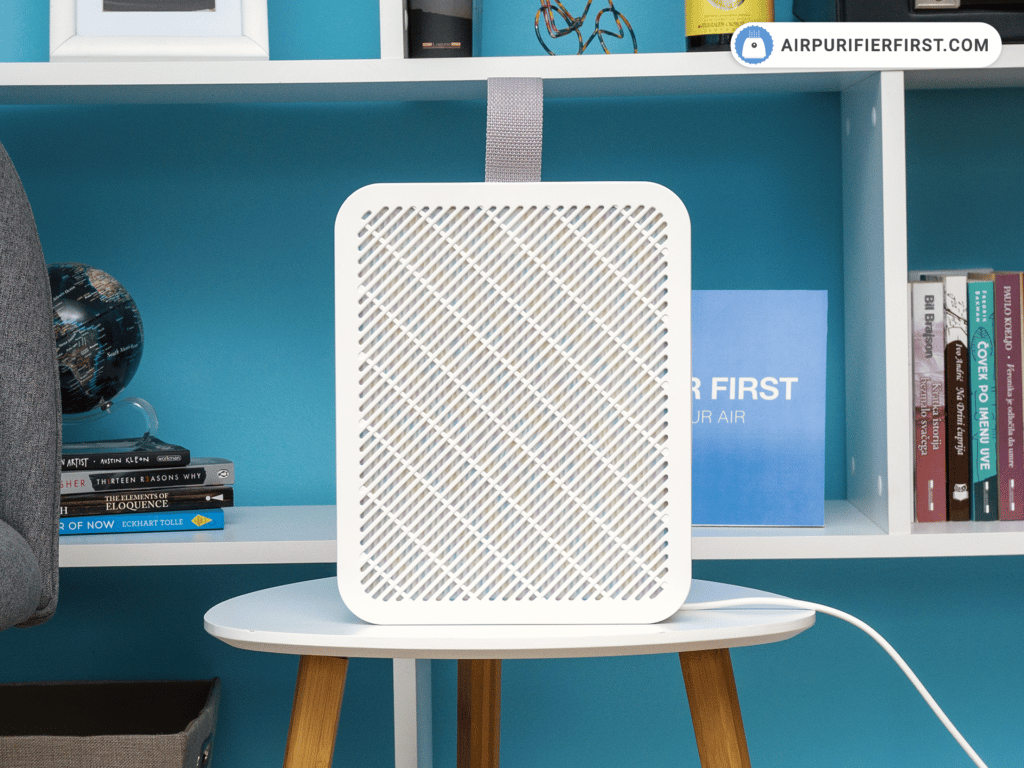
The IKEA UPPÅTVIND is a compact and stylish air purifier intended for small rooms. Its high-efficiency filters effectively remove pollutants such as dust, allergens, and other airborne particles from the air, but it lacks odor-neutralization capabilities.
We tested its performance, noise level, and operating costs and evaluated all the features. So, please keep reading to find out how it did.
How We Tested the IKEA UPPÅTVIND?
1. For the filter efficiency testing, we used the Temtop LKC-1000S laser particle meter, which measures PM2.5 (µg/m3), PM10 (µg/m3), Particles (per/L), and HCHO (mg/m3) in the air, and also calculates the AQI.
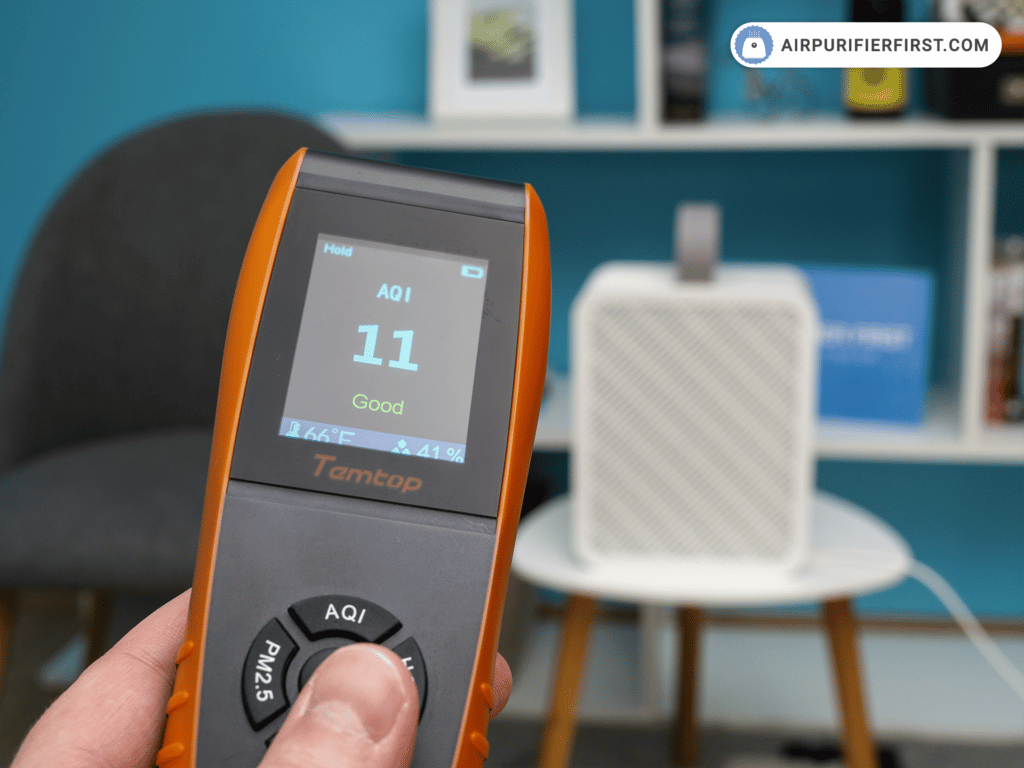
2. We placed the IKEA UPPÅTVIND in two separate performance tests, one in a 120 sq. ft. (11 m²) room and the other in a 194 sq. ft. (18 m²) room. Then, we recorded the initial air quality values using the Temtop laser particle meter and let the IKEA UPPÅTVIND run at maximum speed.
3. After 60 minutes, we measured the new values using the Temtop laser particle meter and saved the data.
4. Next, we placed the IKEA UPPÅTVIND in a glass box, which we then filled with smoke. Then, we measured how much time was needed for the air purifier to remove all the smoke from the box.
5. Using a special noise measurement tool, we tested the air purifier’s noise level at all speeds. We measured the noise level on the dBA scale.
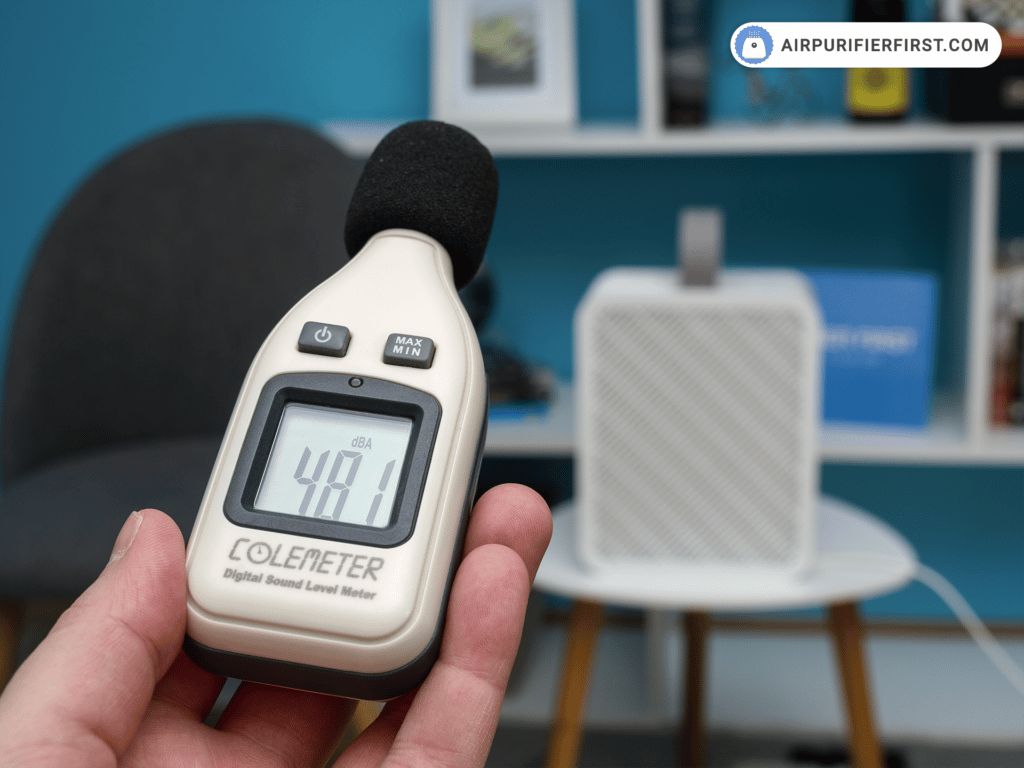
6. Finally, we measured the power usage at all speeds using an energy meter, after which we calculated how much it would cost to use the device at a particular fan speed for one month. For reference, we used an energy price of $0.12 per kWh.
Performance – Particle Removal Tests
Performance – Particle Removal Tests:
8.6 - Average Score (61 products)
9.8 - Best Score (2 products)
2.5 - Worst Score (1 products)
We use the Temtop LKC-1000S laser particle meter to test the particle removal efficiency of every air purifier. It measures PM2.5 (µg/m3), PM10 (µg/m3), Particles (per/L), and HCHO (mg/m3) in the air, and also calculates the AQI.
You can read more about our testing methodology here.
I already mentioned that the IKEA UPPÅTVIND is a small air purifier with a room coverage of only 75 sq. ft. (7 m²).
We tested this air purifier in two rooms larger than the recommended size, mostly because we don’t have an adequate room that is smaller than 120 sq. ft. (please refer to our testing methodology).
In addition to these tests, I used this air purifier for a few days in my home to see how it deals with air pollution in real-life situations. One thing I noticed when using it in my kitchen was that it did almost nothing to remove cooking odors and VOCs.
Testing in a 120 sq. ft. (11 m²) Room
In the first room of 120 sq. ft. (11 m²), which is similar to the recommended dimensions, we tested how much it improved the air quality in 60 minutes.
| # | Starting Baseline | After 60min |
|---|---|---|
| PM 2.5 | 105.9 µg/m³ | 18.1 µg/m³ |
| PM 10 | 148.3 µg/m³ | 25.4 µg/m³ |
| Particles | 153606 per/L | 26375 per/L |
| AQI | 138 | 25 |
The IKEA UPPÅTVIND worked at max speed all the time, and it managed to improve the air quality by about 82%, which is a pretty good result considering its filtration technology and lack of a True HEPA filter.
Testing in a 194 sq. ft. (18 m²) Room
In a second test, this time in a slightly larger room, almost three times the recommended dimensions, the UPPÅTVIND improved air quality by about 75% in 60 minutes.
Particle Removal Test Room - Comparison
Comparison between the IKEA UPPÅTVIND and its competitors in particle removal tests in a 194 sq. ft. (18 m²) room.
This is a slightly weaker result than in the previous test, but that wasn’t surprising given the larger room size. Its bigger brother, the IKEA FÖRNUFTIG, improved the air quality in this test by about 89%, which is a much better result.
Even some other small air purifiers had better results: the Philips Series 800 improved air quality by about 93%, the Medify MA-15 improved it by 92%, and the compact Levoit LV-H132 improved it by 87%.
| # | Starting Baseline | After 60min |
|---|---|---|
| PM 2.5 | 101.9 µg/m³ | 23.3 µg/m³ |
| PM 10 | 142.7 µg/m³ | 32.6 µg/m³ |
| Particles | 147830 per/L | 33867 per/L |
| AQI | 133 | 33 |
Overall, the IKEA UPPÅTVIND hasn’t achieved perfect results, but I believe this is a good result considering its price.
Performance – Smoke Removal Test
The IKEA UPPÅTVIND has a small CADR, which is why I didn’t expect it to perform well in the smoke test.
However, it’s not only because of the low CADR; it also lacks an activated carbon filter, which drastically lowers its performance in odor neutralization.

In the smoke test, the IKEA UPPÅTVIND removed all the smoke from the glass box in 92 seconds, placing it among some of the worst-performing air purifiers we tested.
Smoke Box Test - Comparison
In this chart, you can see how quickly the IKEA UPPÅTVIND removes smoke from a glass box compared to its competitors.
It’s true that there are even worse performers, such as the TaoTronics TT-AP001, which needed 112 seconds, but there are also many other small air purifiers that achieved much better results.
Some of these top performers are the Levoit Core 300S, which needed only 20 seconds, and the Philips Series 800, which needed 33 seconds.
Noise Levels Test
Noise – Sound Level Tests:
9.3 - Average Score (61 products)
10 - Best Score (1 products)
8.2 - Worst Score (1 products)
We use a special noise measurement tool to test the noise level of the air purifier at all speeds. We measure the noise level on the dBA scale.
You can read more about our testing methodology here.
When we test noise levels, we always test the noise at each speed separately, then compare the results with the noise level tests of competing air purifiers.
The IKEA UPPÅTVIND has only three fan speeds, which made this test very simple. Using a special tool that measures the sound volume on a dBA scale, we tested the volume at all three speeds separately.
Noise Levels Test - Comparison
This chart compares the noise levels at the minimum and maximum speeds of the IKEA UPPÅTVIND air purifier with those of its competitors.
I noticed (even without testing) that the UPPÅTVIND is a very quiet air purifier. On the first speed, it produces a sound of only 42.5 dBA, making it an ideal choice for the bedroom. Not many competitive air purifiers are quieter than this, except for the Medify MA-15 (41.2 dBA) and the TaoTronics TT-AP001 (41.6 dBA).
| Fan Speed | IKEA UPPÅTVIND (dBA) |
|---|---|
| Speed 1 (Low) | 42.5 dBA |
| Speed 2 (Medium) | 47.2 dBA |
| Speed 3 (High) | 53.8 dBA |
At maximum speed, the situation is equally good, and I can say much better than some competing devices. At this speed, the IKEA UPPÅTVIND produces a sound of only 53.8 dBA. In comparison, the Levoit Core 300S produces a sound of 65.2 dBA at its maximum speed.
Undoubtedly, the IKEA UPPÅTVIND is one of the quietest air purifiers we have tested!
Where IKEA has definitely done a great job is in optimizing the motor. The UPPÅTVIND uses a motor with a power of only 19W.
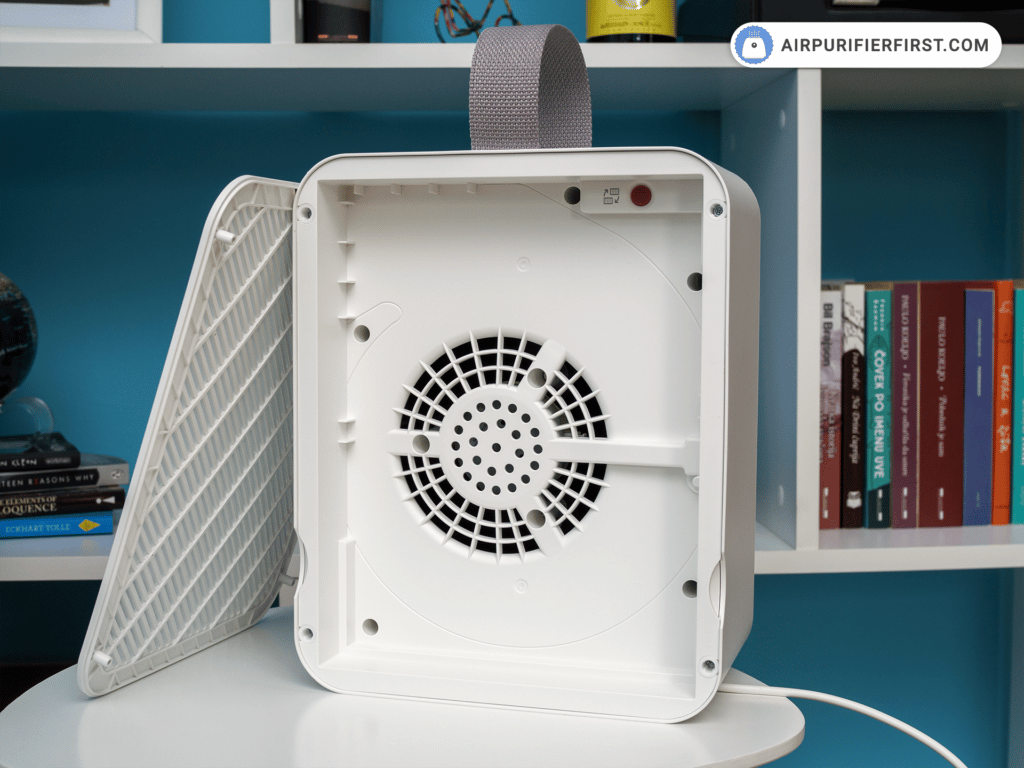
However, it uses only 6.7W at maximum speed, meaning it’s not a huge power consumer. If you used it at maximum speed, 24 hours a day, for one month, your electric bill would increase by about $0.59, which is extremely low, especially considering that you probably won’t use it at max speed all the time. So, the cost would be even lower!
Monthly Power Cost – Comparison
Comparison of the monthly power cost at maximum speed between the IKEA UPPÅTVIND and some of its competitors.
Compared to some similar air purifiers, there are barely a few devices that use less power than this IKEA. As you can see on the chart above, only the TaoTronics TT-AP001 would cost you less, about $0.49.
| Fan Speed | IKEA UPPÅTVIND (W + $/month) |
|---|---|
| Standby | 0W ($0) |
| Speed 1 (Low) | 1.7W ($0.15) |
| Speed 2 (Medium) | 3.5W ($0.31) |
| Speed 3 (High) | 6.7W ($0.59) |
If we consider the price of the replacement filter and the power usage costs, we can easily calculate the annual price you would need to pay for your IKEA UPPÅTVIND maintenance. The conclusion is that the IKEA UPPÅTVIND is one of the most affordable air purifiers among all we have tested so far.
Filtration Technology
When it comes to filtration technology, I can’t say that it’s the UPPÅTVIND’s trump card, and it’s something that this air purifier can boast about.
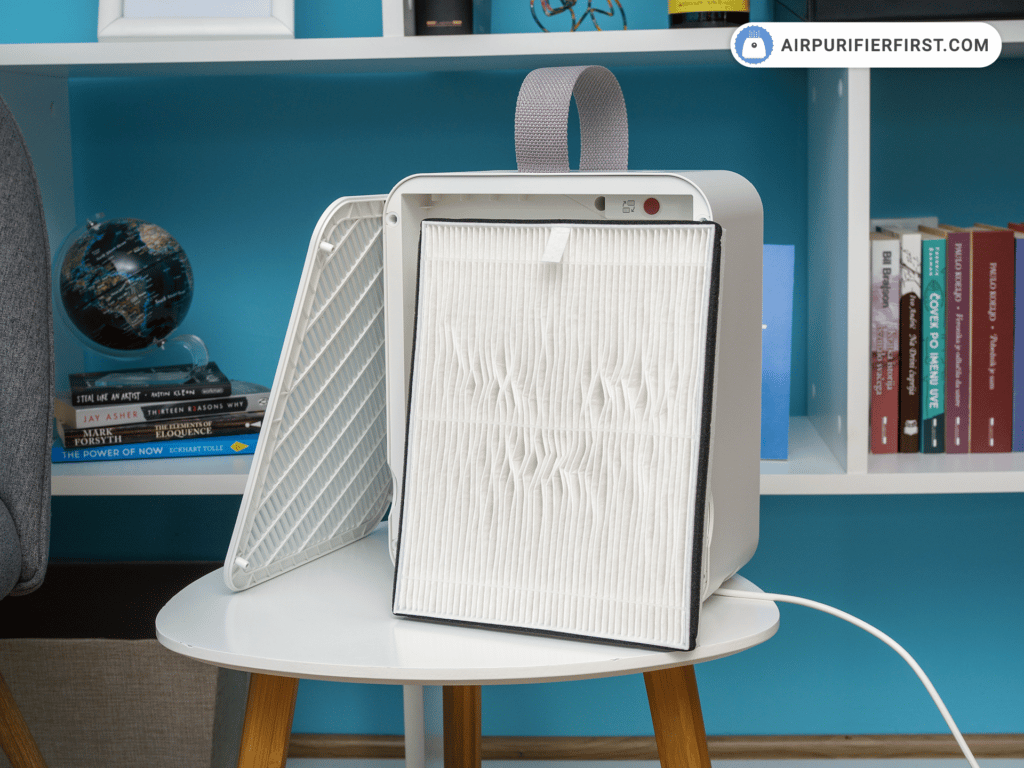
This air purifier uses a very basic 2-stage filtration technology and does not have a carbon filter, making it less effective in eliminating VOCs and fighting odors.
Pre-filter
The pre-filter is the first stage of filtration, it is a nylon mesh attached to the front cover.
The primary purpose of the pre-filter is to collect any large particles of dust, hair, pet hair, and other large particles, thus preserving and extending the life of the HEPA filter.
The pre-filter is washable and should not be changed, and it is recommended to clean it with a vacuum cleaner or wash it at least once every two weeks.
Particle Filter
Basically, the UPPÅTVIND uses a HEPA H12 filter, which is much less efficient than the True HEPA filter we are used to seeing in many air purifiers tested so far. This particulate filter on the IKEA air purifier can help remove more than 99.5% of small airborne particles, such as PM2.5, dust, and pollen.
PM2.5 is a small, inhalable particle measuring 0.1-2.5 microns. Given that the traditional True HEPA filter removes 99.97% of airborne particles, I can’t help but point out that I expected more from IKEA and that a higher-quality filter would have taken this air purifier up a notch.
How To Change the IKEA UPPÅTVIND Filter?
As I already said, the pre-filter is washable and doesn’t need to be changed. All needed is to wash this filter every now and then, approximately between 2-4 weeks, or vacuum the dust off it with a vacuum cleaner.
As far as the particle filter is concerned, it is not washable and needs to be changed periodically, more specifically, approximately every 6 months.
Fortunately, the IKEA UPPÅTVIND has a filter reset indicator that lets you know when it’s time to change the filter. The process of changing the filter on this air purifier is straightforward.
Setup and Installation
Before you start using this appliance, you need to make specific preparations. Basically, you just need to prepare the filter.
The filter comes with the device, already installed, but packed in a protection sheet. So you need to open the cover on the front of the air purifier, pull out the filter, unpack it from the plastic wrap, and then put it back in the air purifier.
This is basically everything you need to do before starting the IKEA air purifier for the first time. Now, you can place it in the desired location, but keep in mind to place it at least 10 inches (about 25 cm) away from the wall or other objects, plug it in, and turn it on.
Design
At first glance, the IKEA UPPÅTVIND looks like a larger speaker. It is rectangular in shape, with a carrying handle attached to the top of the unit. This air purifier was designed by David Wahl. The same person also designed the IKEA FÖRNUFTIG, which I also thoroughly tested and reviewed not so long ago.
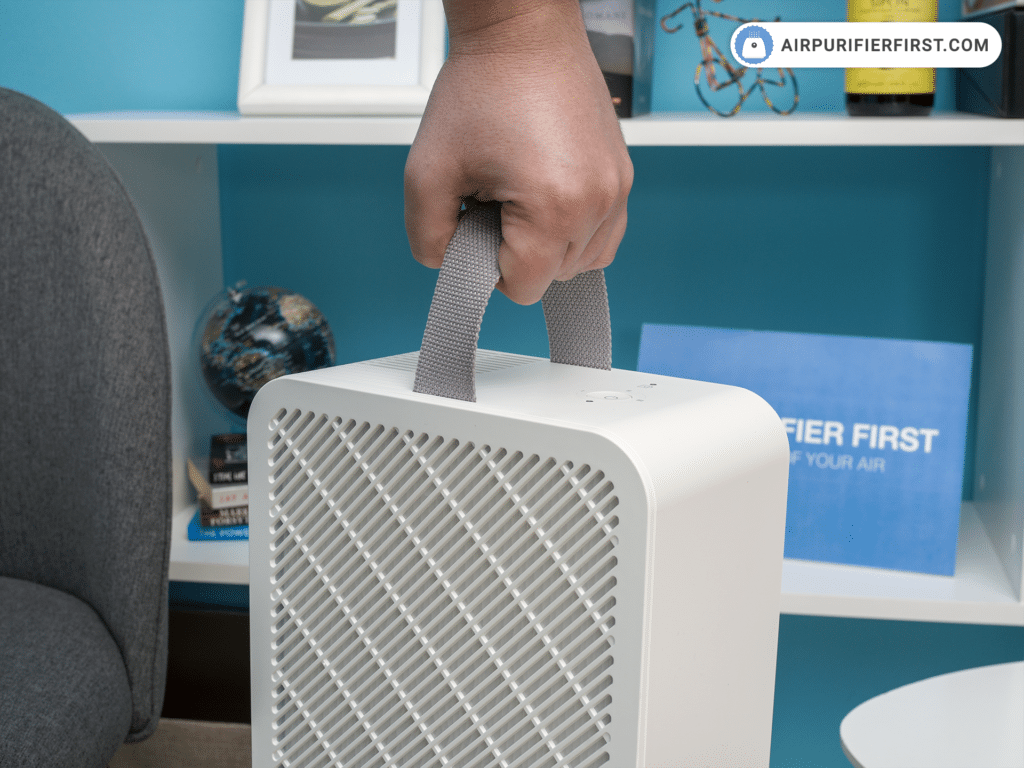
What I like about the UPPÅTVIND is its simple, clean, and minimalist design, which gives the impression that this device fits almost anywhere you place it.
As far as build quality is concerned, I am satisfied with both the device assembly and the plastic quality. I would also point out that this air purifier is very light, compact and you can carry it from one location to another without any problems.
In general, I really like the design of the UPPÅTVIND, and I give this air purifier a positive review.
Device Control
The IKEA UPPÅTVIND differs from the FÖRNUFTIG in many ways, but what I find most interesting is that the UPPÅTVIND uses an electronic control knob, as opposed to the latter’s mechanical knob. This means that you won’t be able to connect the UPPÅTVIND to a smart plug, so you won’t be able to plug in some extra options.
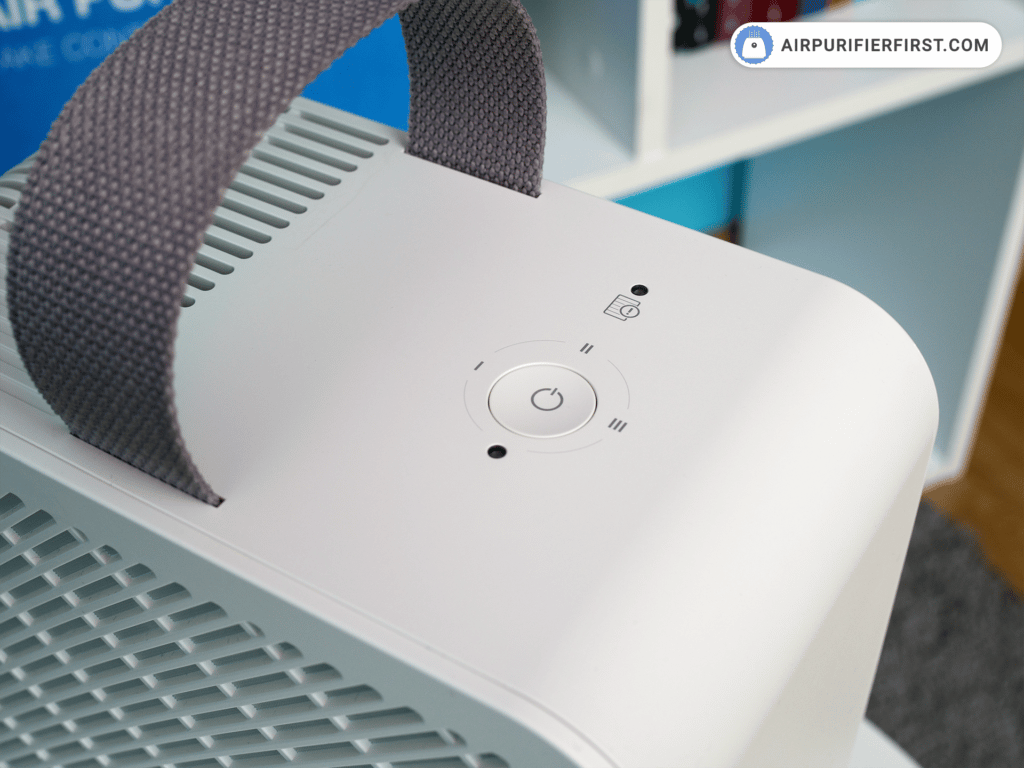
Basically, you control the IKEA UPPÅTVIND via a button on the top of the device. Each button press changes the fan speed until you reach the third speed, then the next press turns the device off, and so in a circle.
The filter reset indicator button is one more button on this air purifier, which is located just below the filter. So you have to remove the filter to get to this button.
Airflow
The IKEA UPPÅTVIND is a rectangular-shaped air purifier, but with a slightly unusual design, so the airflow is interesting in this model. Basically, the UPPÅTVIND draws air through vents on the front cover, which is then filtered and exits through vents on the top left side (when viewed from the front).
Please, keep in mind that it is extremely important to pay attention to the air inlet and outlet openings when placing the air purifier. You mustn’t block these openings!
Size and Dimensions
The air purifier weighs 3.52 lb (1,6 kg). The device dimensions are 11 x 8.8 x 4.9 inches (28,0 x 22,5 x 12,5 cm). The IKEA UPPÅTVIND is an extremely light, compact, and relatively small air purifier that will not take up much space wherever you put it.
What’s in the box?
When you buy the purifier, you get an IKEA UPPÅTVIND air purifier, particle filter, power cord, and user manual.
I noticed that the biggest concern among users is whether the filter is included with the device. The answer is that the filter is included with the UPPÅTVIND air purifier, which means you don’t need to buy it until it’s time to replace it.
Features Overview
As I already pointed out in the review, the IKEA UPPÅTVIND does not have any features. It’s basically a very minimalistic air purifier that reminds me a lot of the Blueair 411, mainly because of the control knob that works in the same way.
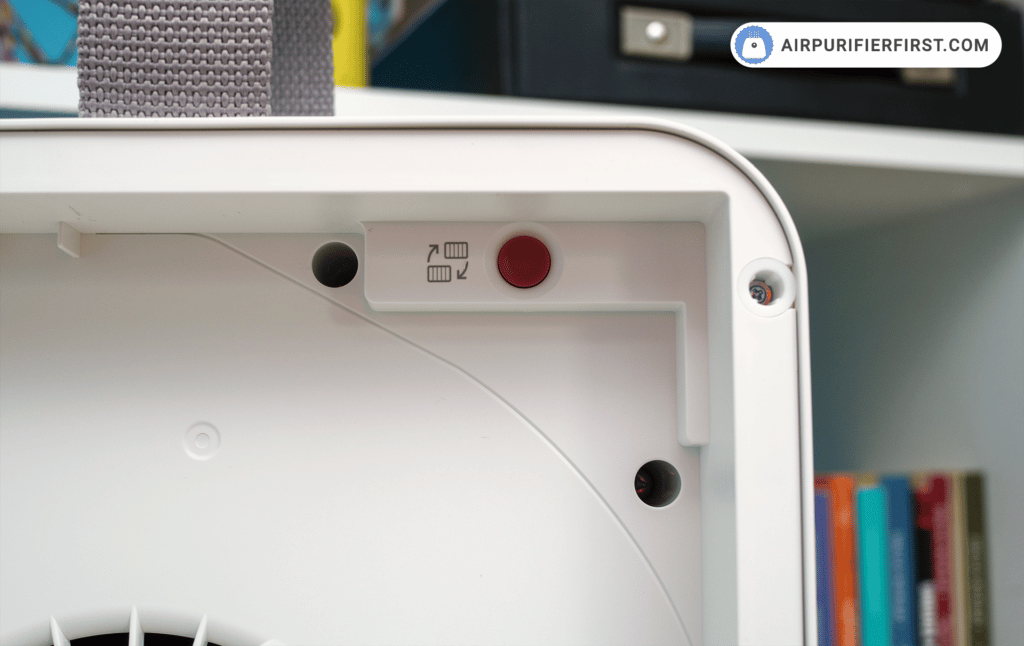
But not everything is that dark. The IKEA has a filter reset indicator that lights up when it’s time to change the filter, letting you know that you need to replace the old/soiled filter as soon as possible. Apart from this indicator, I have nothing else to add as a feature of this device.
The only thing that is also important to mention is that the IKEA UPPÅTVIND comes without a warranty. This may be slightly strange information, but I have received confirmation of this information from IKEA’s support and in the store. Even if it is a durable device that not easily breaks down, the lack of a warranty seems to me to be a big concern that IKEA definitely needs to work on.
All in all, maybe the IKEA UPPÅTVIND’s minimalism is what people love and why it is so popular.
Room Coverage
The IKEA UPPÅTVIND is a very small air purifier that covers rooms up to 75 sq. ft. (7 m²). This air purifier cleans the air in a room of these dimensions 4.8 times in one hour. It is an industry standard and one of the basic parameters to look out for when choosing an air purifier. The IKEA UPPÅTVIND has a maximum CADR of 95 m³/h, which is solid for such a small machine. The GermGuardian AC4200W is in a similar category but with slightly more coverage, which I have also tested in detail. I recommend you read that review as well.
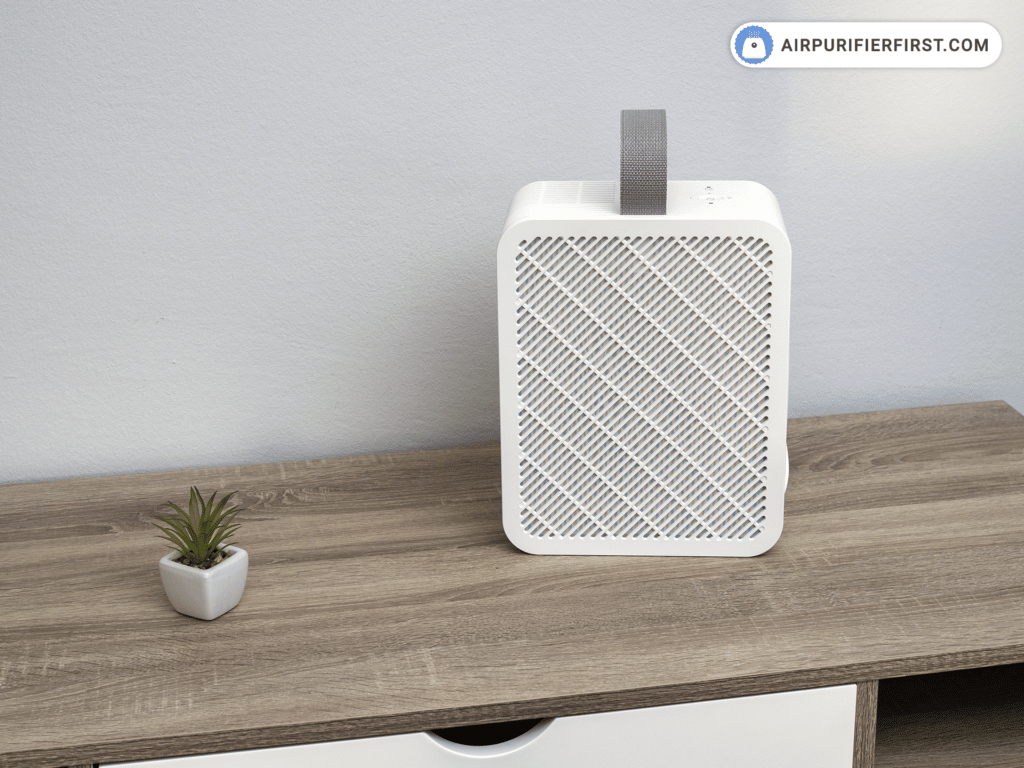
I would recommend this air purifier for some smaller rooms, such as offices, small bedrooms, children’s rooms, or any other room of similar dimensions. I would not recommend this air purifier for rooms larger than 100 sq. ft., especially as there are many air purifiers on the market for larger rooms, many of which I have tested and reviewed here on the Air Purifier First website.
FAQ on IKEA UPPÅTVIND
Does IKEA UPPÅTVIND produce ozone?
No. This air purifier doesn’t use an ionizer or any other filter technology that could produce ozone, which means it is ozone-free and entirely safe for use.
What is the IKEA UPPÅTVIND warranty?
Unfortunately, IKEA doesn’t guarantee the UPPÅTVIND air purifier.
Does IKEA UPPÅTVIND have a carbon filter?
It doesn’t. The IKEA UPPÅTVIND does not have a filter upgrade option nor the option to add a carbon filter, which makes its performance in neutralizing odors much worse than expected.
Just bought this today from my testing it has a “power loss memory” so to say. That means for example if I unplug it while it was running at Speed 2 or turn it off with a smart plug, then it will turn on back at Speed 2 once I plug it back in or switch on the smart plug.
Hi Milan,
I’ve had a few more thoughts that might help.
If you can take a few more readings of PM throughout the test, you could plot these with a line of best-fit. This should be exponential in nature, so a log scale might be best. Thus would allow easier comparison of modes/models etc., but it is more work! This would also reduce the bias of just having a few data points.
If you really want to be more technical, you could also calculate expected values. For example, if we assume an air volume of 50m^3 and a CADR of 200m^3/hr, we’d expect 200/50=4 air changes per hour. For 1 hour, we can then calculate e^(-4*1) ~= 0.0183. If we start at say 105 µg/m^3 with expected settling level of 5µg/m^3, we have 105-5=100 µg/m^3 that could be removed. 100*0.0183 = 1.832. Adding on the 5µg/m^3 again gives an expected 6.832µg/m^3. In theory, in a sealed room we’d expect the value to trend to 0, but I doubt that would happen in the real world. Likewise, to work the other way, we could take the natural log of the ratio we obtain, for example ln(0.0183)~=-4, indicating 4 air changes.
For the 120ft^2 test:
ln(18.1/105.9)~=-1.767 air changes.
Assuming 26.6m^3 over 1hr: (26.6*1.767)/1 ~= 47m^3/hr.
It would be interesting to know how well a simplified model like this, that assumes ideal conditions, works. It may be inaccurate in practice, particularly if the room is not well sealed.
I think sound levels are usually measured at 1M.
This is all more technical work, but hopefully it sparks some ideas that might help.
Thanks for the review! There’s some useful data here.
There’s some conflicting information here, such as:
“The pre-filter is not washable”
“As I already said, the pre-filter is washable and doesn’t need to be changed.”
The noise test also does not mention the distance the SPL was measured at.
Interestingly, the 194 ft^2 test (about 18m^2) seems rather slow. Assuming 2.4m high ceiling, that’s about 43m^3. A reduction from 101.9 to 23.3 for PM2.5 (I assume this is µg/m^3, but it’s not stated) over an hour corresponds to a time constant of about 41 minutes, or an estimated CADR of 63m^3/hr, less than claimed by Ikea, although this does not account for any other air exchange in the room, and is just for 2 data points, so maybe that doesn’t mean much. It would be interesting to see if this holds true in repeated tests with more data points and a least-squares regression.
Hi Anon,
Thanks for your suggestions. I’ve corrected the typo related to the pre-filter.
I also appreciate your detailed analysis of my tests. Your insights have provided me with ideas for content improvements. I realize that adding information such as “how we measured” could be beneficial for readers and should be placed near the test results. Thanks again.
It comes with a handle so it could be hung
Yes, it comes with a handle, but it’s not very practical to use it for hanging on the wall or elsewhere.
Does this come with the ability to wall-mount the air purifier?
No, it doesn’t. But, the IKEA FÖRNUFTIG does.